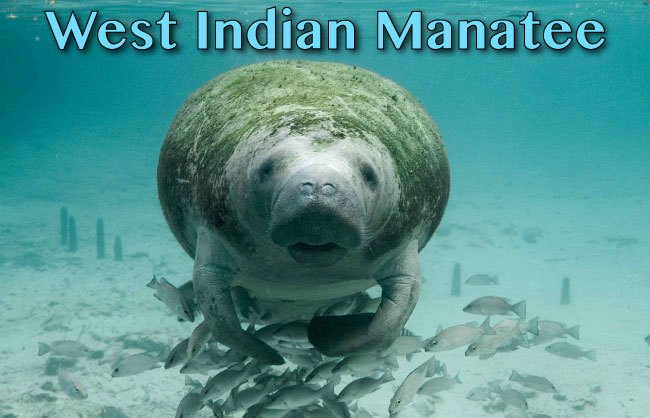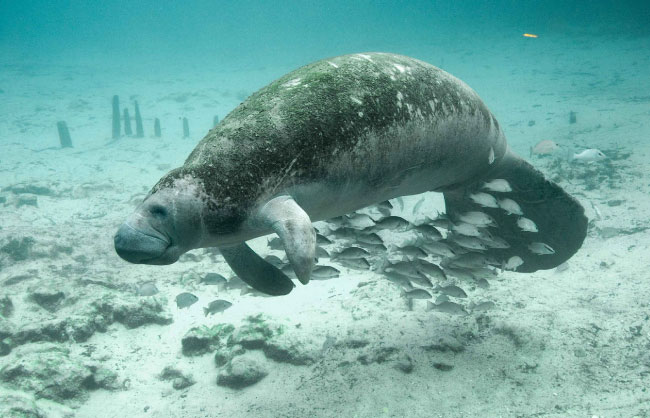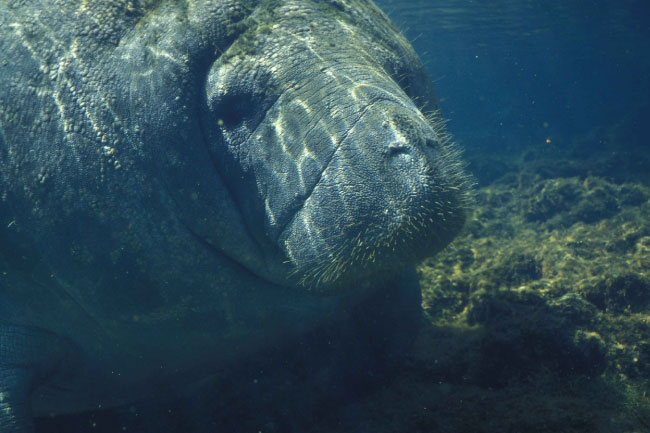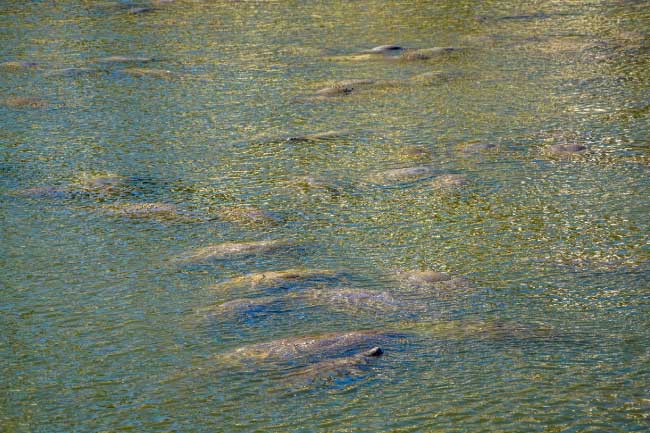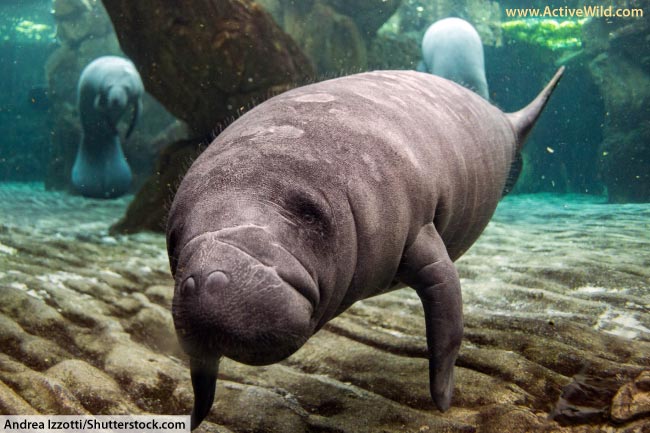West Indian manatee facts: learn about these gentle aquatic giants with awesome pictures and in-depth information …
West Indian Manatee
- Other Name: American manatee
- Scientific name: Trichechus manatus
- Type of Animal: Mammal
- Animal Family: Trichechidae
- Where Found: Along the coast of Florida, the Gulf Coast and the Caribbean
- Length: 2.7 to 3.5m (8.9 to 11.5ft)
- Weight: 200 to 600kg (440 to 1,320lb), females are larger than males.
- Conservation Status: Vulnerable
- Other interesting West Indian Manatee facts: The molars of a West Indian manatee are called "marching molars" because they are replaced several times during the animal's life.
Meet The West Indian Manatee: Introduction
The West Indian manatee is the largest of the three living manatee species. This family of aquatic mammals is sometimes known as "sea cows" because they move slowly through the water while grazing on aquatic plants, resembling their land-based namesakes.
The Sea Cow Family
The scientific name for the sea cow family is Trichechidae. The other two members of Trichechidae are the Amazonian manatee Trichechus inunguis and the West African manatee Trichechus senegalensis.
The sea cow family is part of the order Sirenia. The only other living species in this order is the dugong. You can find out about dugongs here: Dugong Facts.
Confused by terms such as ‘families’ and ‘orders’? Check out our Animal Classification page and all will become clear!
West Indian Manatee Video
You can see manatees in the wild in the video below:
West Indian Manatee Subspecies
Two subspecies of West Indian manatee are recognized: the Florida manatee Trichechus manatus latirostris (also known as the North American manatee), and the Antillean manatee (Trichechus manatus manatus) (also known as the Caribbean manatee).
The Florida manatee is usually found along the Florida coast and the Gulf Coast. The Antillean manatee is typically found in the Caribbean, as well as in the northern and northeastern coasts of South America.
What Does the West Indian Manatee Look Like?
The West Indian manatee has an elongated body shape typical of aquatic mammals. The flippers on either side of its body each have three or four nails. It propels itself through the water with a big, paddle-shaped tail.
The West Indian manatee is usually grey, but color variations from light brown to black exist. Its skin is wrinkled with a sparse cover of hair and sometimes has patches of algae growing on it.
Vibrissae: Tactile Hairs
The hairs on the West Indian manatee's body and face are called vibrissae (commonly known as whiskers in many mammal species). They offer no protection or warmth, but are assumed to give the manatee information about water movements and to help it navigate in murky waters.
Manatees and dugongs are the only mammals to have no other type of hair other than vibrissae.
West Indian Manatee Habitat
The West Indian manatee favors freshwater environments, but is also found in brackish (a mix of fresh and salt water) and saltwater systems. It has been observed in rivers, estuaries, canals, lagoons, coastal areas and saltwater bays.
Shallow, slow-moving waters of inland waters and areas near the shore with dense underwater vegetation are the manatee’s preferred habitats.
Seasonal Migration
Because it lacks insulating body fat and has a slow metabolic rate, the West Indian manatee has to seek warm waters in order to survive the winter.
For the Florida manatee, a drop below 20°C (68°F) in water temperature begins the winter migration to springs and power plant outfalls that offer natural and artificial warm-water refuges.
Large winter aggregations of over 100 animals have been seen in central and southern Florida, with many manatees returning to a specific site each winter.
When the waters begin to warm again in spring, the Florida manatees leave their winter grounds and scatter around the major rivers of Florida as well as coastal waters. They can migrate as far as North Carolina.
West Indian Manatee Facts: Behavior
Using its flippers and large paddle, the West Indian manatee is capable of agile movements from rolls to somersaults.
It communicates using touch and via vocal signals, which are especially important to mother-calf pairs.
The West Indian manatee likes to stay near the surface, holding its muzzle above the water, though it can spend up to 12 minutes underwater before surfacing to breathe.
The West Indian manatee has no natural predators and is not territorial.
What Do Manatees Eat?
The West Indian manatee is primarily a herbivore, feeding on a wide range of floating and submerged aquatic plant species as well as shoreline vegetation. Sea grasses (such as eelgrass, turtle grass and cord grass) form a major part of its diet. The Antillean manatee is also known to eat fish on occasion.
An individual manatee spends five to eight hours a day feeding, consuming 4% to 9% of its body weight in plants. It forages for food either by uprooting plants with its flippers and eating them whole, or by grasping the vegetation with its upper lip and grazing on the visible parts.
West Indian Manatee Breeding
The West Indian manatee has no mating season. Temporary 'mating herds' with one female and several males can form any time of year, with the male manatees competing over the female for several weeks.
The female gives birth to one calf (on rare occasions two calves) after an estimated 11 to 14 months of pregnancy. She nurses her calf for one to two years, although the young are born with molars and are able to feed on sea grasses within a few weeks after being born. A female gives birth to a calf every two to five years.
Is The West Indian Manatee Threatened?
The West Indian manatee is currently rated 'Vulnerable' by the IUCN.
The West Indian manatee is affected by natural threats such as extremely cold winters, hurricanes and harmful algal blooms. However, the greatest danger to the species' survival is caused by human activity.
The main threats facing the Florida manatee are:
- Boat strikes. Collisions with watercraft is the major cause of death, and is responsible for approximately 25% of all Florida manatee deaths.
- Loss of habitat. Loss of winter refuges is the biggest long-term threat to the Florida manatee. Human-made warm-water sites (such as power plant outlets) are disappearing due to the adoption of new technology resulting in the closure of aging power-plants. Natural warm-water refuges are being lost due to development and human demand for ground water.
The main threats for the Antillean manatee vary across its range but include:
- Hunting. The manatee is targeted by illegal hunting and is taken as bycatch. (Bycatch occurs when another species is being targeted, but the manatee is injured or killed as a result.)
- Boat strikes.
- Entanglement in fishing gear.
- Pollution. Agricultural and mining pollution are problematic in South America.
West Indian Manatee Facts: Conclusion
We hope that you have enjoyed finding out about this gentle giant. You can find out about other awesome aquatic mammals in the pages below:

